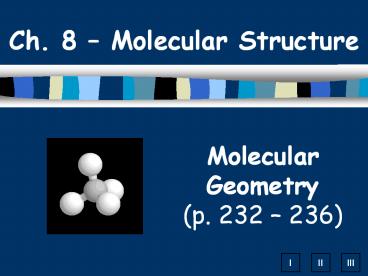Molecular Geometry (p. 232 – 236) PowerPoint PPT Presentation
1 / 24
Title: Molecular Geometry (p. 232 – 236)
1
Molecular Geometry(p. 232 236)
- Ch. 8 Molecular Structure
2
Teacher Notes Why VSEPR?
3
A. VSEPR Theory
- Valence Shell Electron Pair Repulsion Theory
- Electron pairs orient themselves in order to
minimize repulsive forces
4
A. VSEPR Theory
- Types of e- Pairs
- Bonding pairs form bonds
- Lone pairs nonbonding e-
- Total e- pairs bonding lone pairs
5
A. VSEPR Theory
- Lone pairs reduce the bond angle between atoms
6
B. Determining Molecular Shape
- Draw the Lewis Diagram
- Tally up e- pairs on central atom (bonds lone
pairs) - double/triple bonds ONE pair
- Shape is determined by the of bonding pairs and
lone pairs
7
C. Common Molecular Shapes 1
- ? Electronic Geometry linear
- Hybridization sp
- 2 total
- 2 bond
- 0 lone
LINEAR 180
8
C. Common Molecular Shapes 2
? Electronic Geometry trigonal
planar Hybridization sp2
- 3 total
- 3 bond
- 0 lone
TRIGONAL PLANAR 120
9
C. Common Molecular Shapes 3
? Electronic Geometry trigonal
planar Hybridization sp2
- 3 total
- 2 bond
- 1 lone
BENT lt120
10
C. Common Molecular Shapes 4
? Electronic Geometry tetrahedral Hybridiza
tion sp3
- 4 total
- 4 bond
- 0 lone
TETRAHEDRAL 109.5
11
C. Common Molecular Shapes 5
? Electronic Geometry tetrahedral Hybridiza
tion sp3
- 4 total
- 3 bond
- 1 lone
TRIGONAL PYRAMIDAL 107
lt109.5
12
C. Common Molecular Shapes 6
? Electronic Geometry tetrahedral Hybridiza
tion sp3
- 4 total
- 2 bond
- 2 lone
BENT 104.5
lt109.5
13
C. Common Molecular Shapes 7
? Electronic Geometry trigonal
bipyramidal Hybridization sp3d
- 5 total
- 5 bond
- 0 lone
TRIGONAL BIPYRAMIDAL 120/90
14
C. Common Molecular Shapes 8
? Electronic Geometry trigonal
bipyramidal Hybridization sp3d
- 5 total
- 4 bond
- 1 lone
SEESAW lt120/lt90
15
C. Common Molecular Shapes 9
? Electronic Geometry trigonal
bipyramidal Hybridization sp3d
- 5 total
- 3 bond
- 2 lone
T-SHAPE lt90
16
C. Common Molecular Shapes 10
? Electronic Geometry trigonal
bipyramidal Hybridization sp3d
- 5 total
- 2 bond
- 3 lone
LINEAR 180
17
C. Common Molecular Shapes 11
? Electronic Geometry octahedral Hybridizat
ion sp3d2
- 6 total
- 6 bond
- 0 lone
OCTAHEDRAL 90
18
C. Common Molecular Shapes 12
? Electronic Geometry octahedral Hybridizat
ion sp3d2
- 6 total
- 5 bond
- 1 lone
SQUARE PYRAMIDAL lt90
19
C. Common Molecular Shapes 13
? Electronic Geometry octahedral Hybridizat
ion sp3d2
- 6 total
- 4 bond
- 2 lone
SQUARE PLANAR 90
20
D. Examples
- SeO3
3 total 3 bond 0 lone
E.G. TRIGONAL PLANAR M.G. TRIGONAL PLANAR 120
Hybridization sp2
21
D. Examples
- AsH3
4 total 3 bond 1 lone
E.G. TETRAHEDRAL M.G. TRIGONAL
PYRAMIDAL 107 (lt109.5)
Hybridization sp3
22
E. Hybridization
- Provides information about molecular bonding and
molecular shape - Several atomic orbitals mix to form same total of
equivalent hybrid orbitals
23
E. Hybridization
- Carbon is common example (orbital diagram)
- One of 2s electrons is promoted to 2p
- 4 identical orbitals form sp3 hybridization
24
E. Hybridization
- Other types of hybridization
- BeH2 forms
- AlCl3 forms
- SiF4 forms
- KrF4 forms
- SF4 forms
sp sp2 sp3 d2sp3 or sp3d2 dsp3 or sp3d
exceptions
25
F. Hybridization Example
- Compare shapes and hybrid orbitals
- PF3 PF5

